
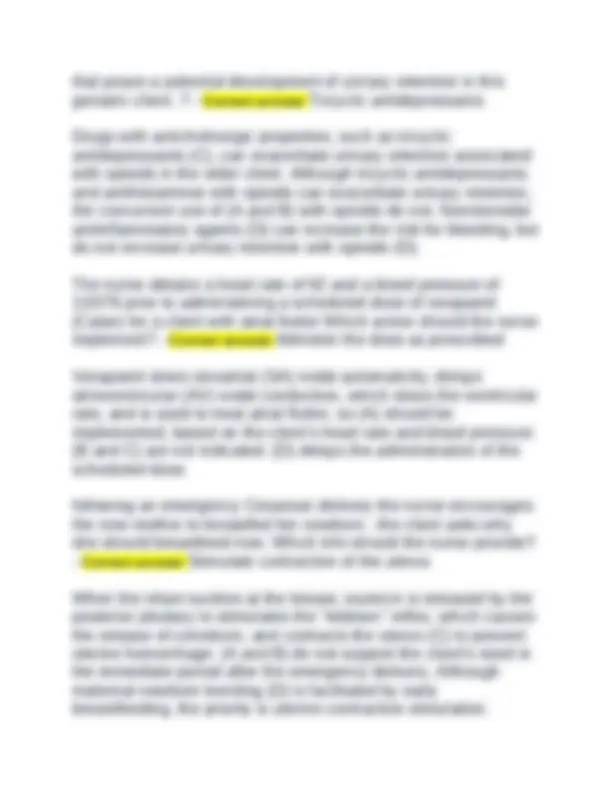
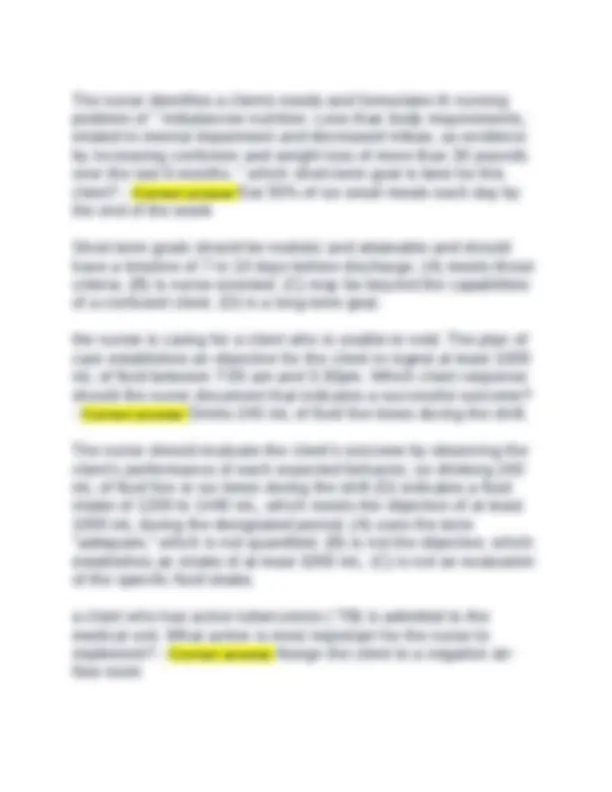
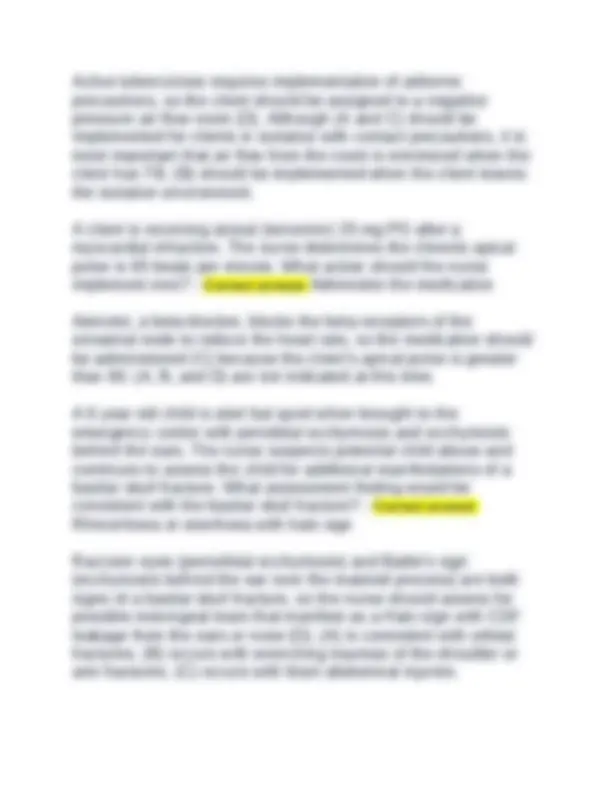
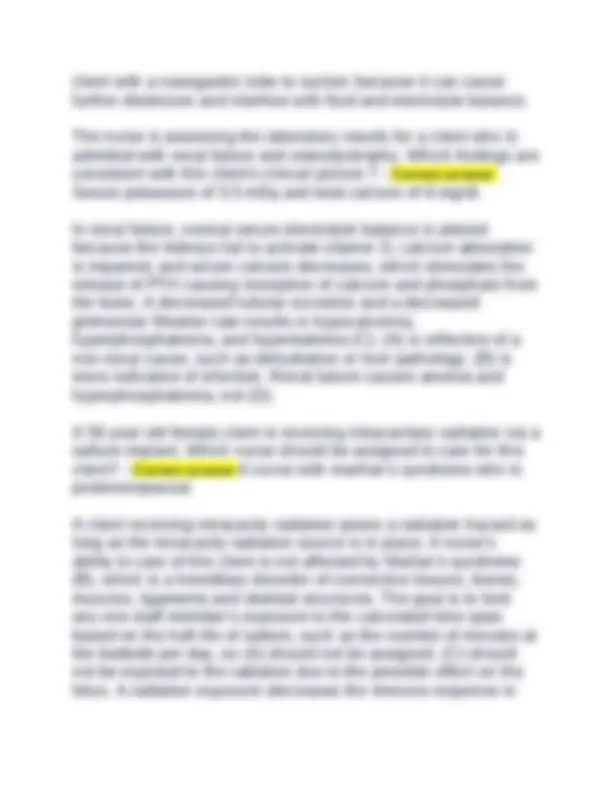

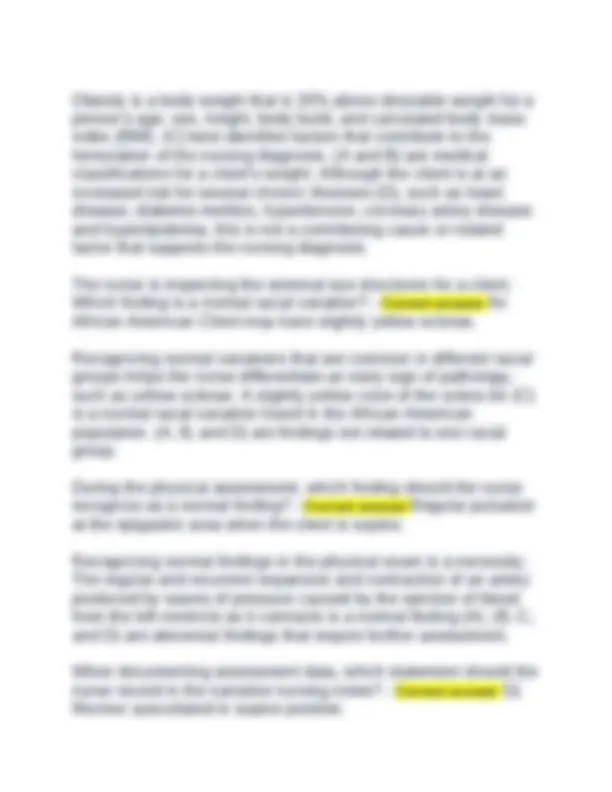
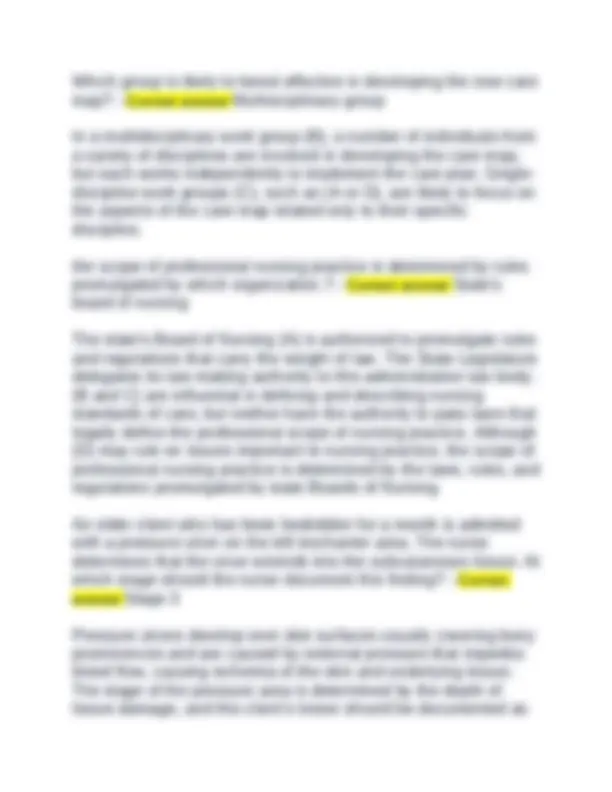
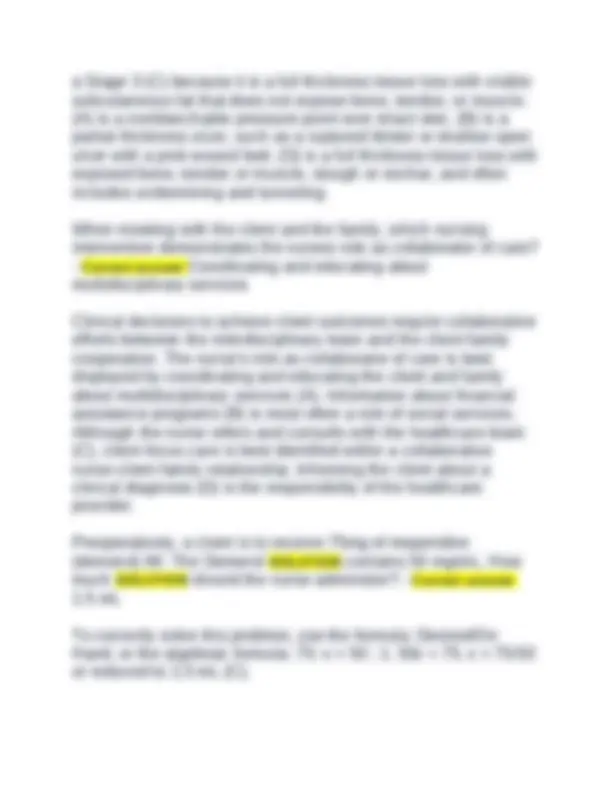
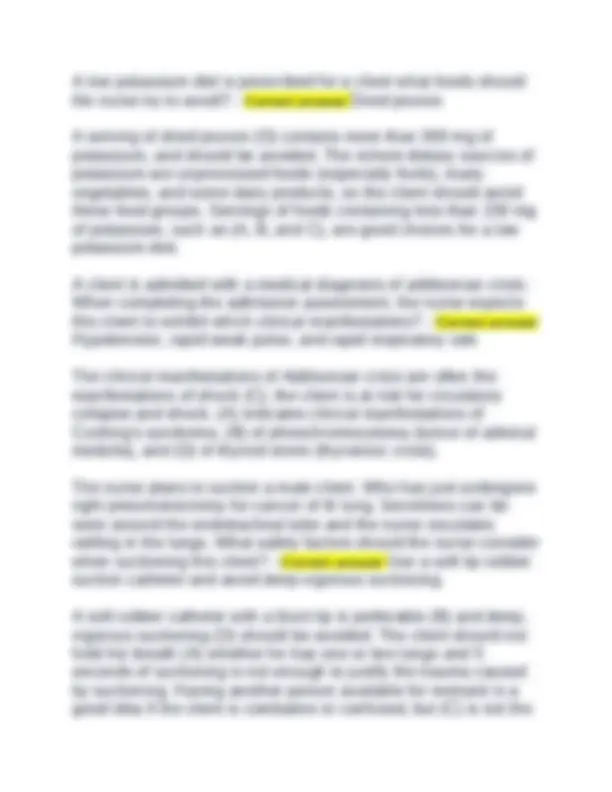
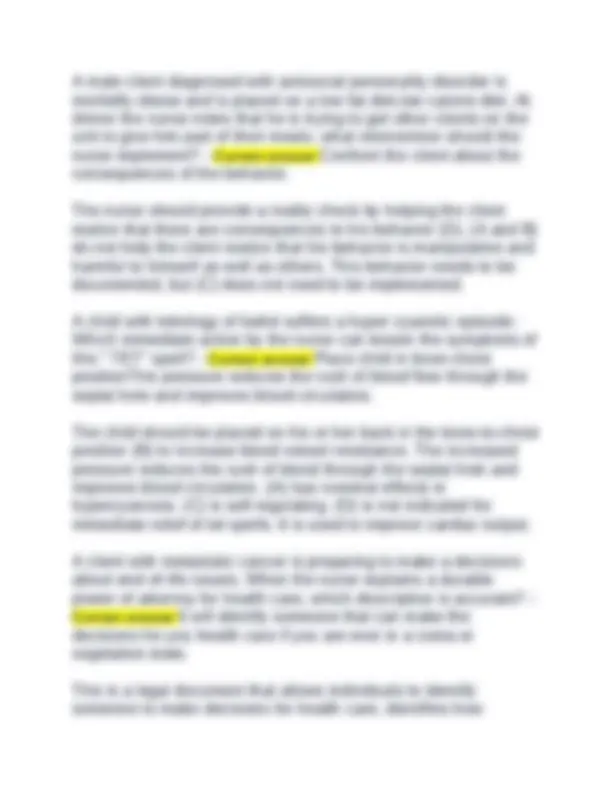
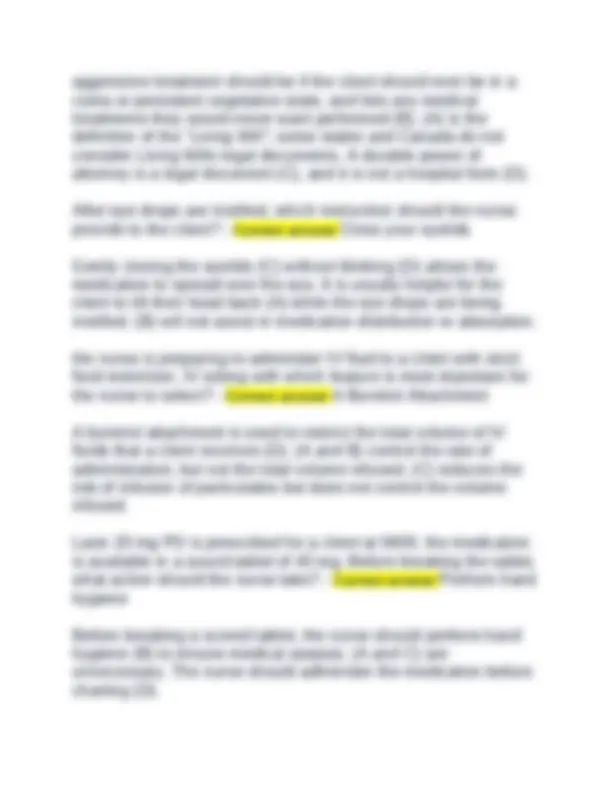
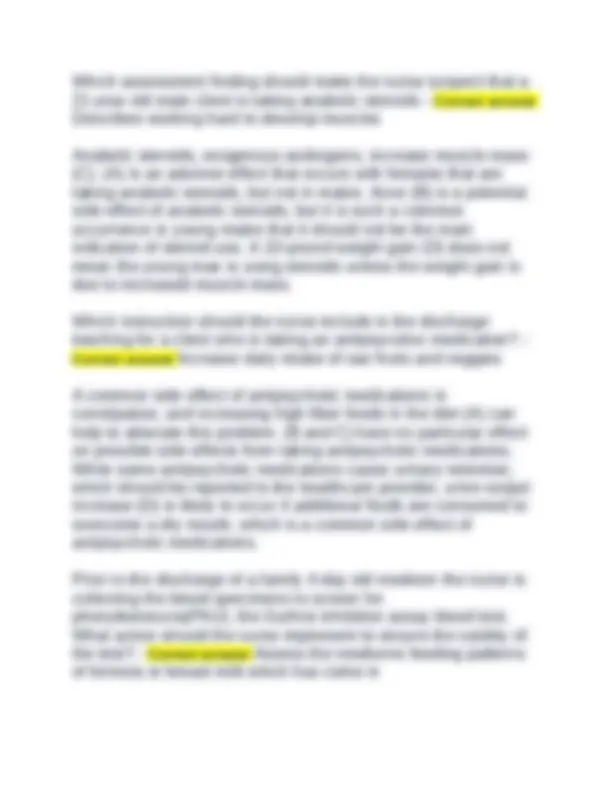
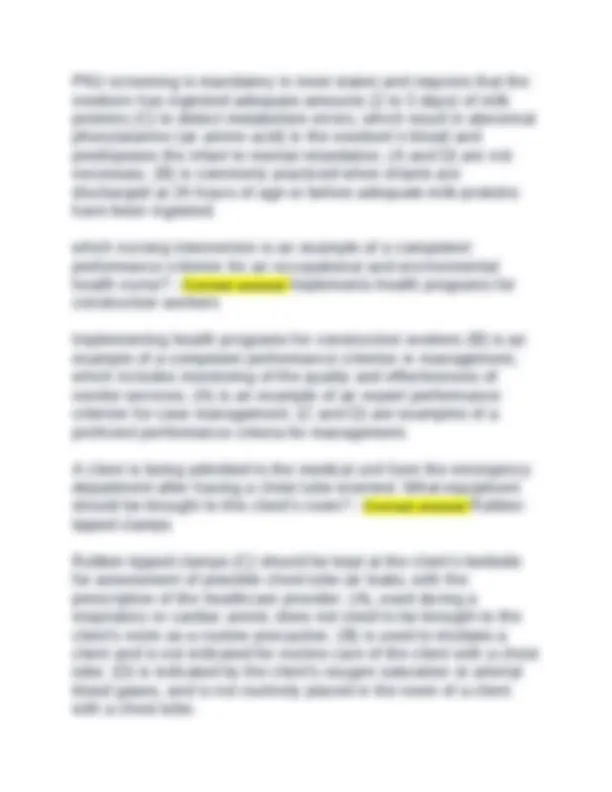
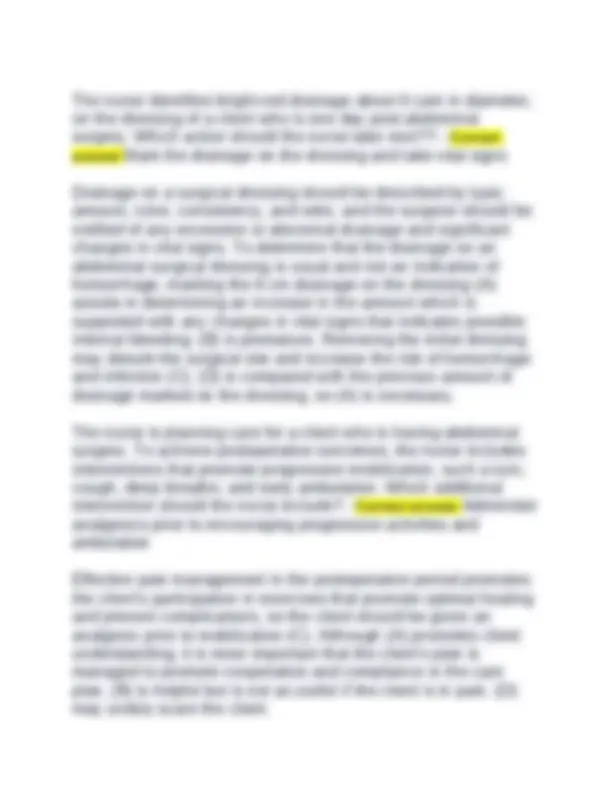
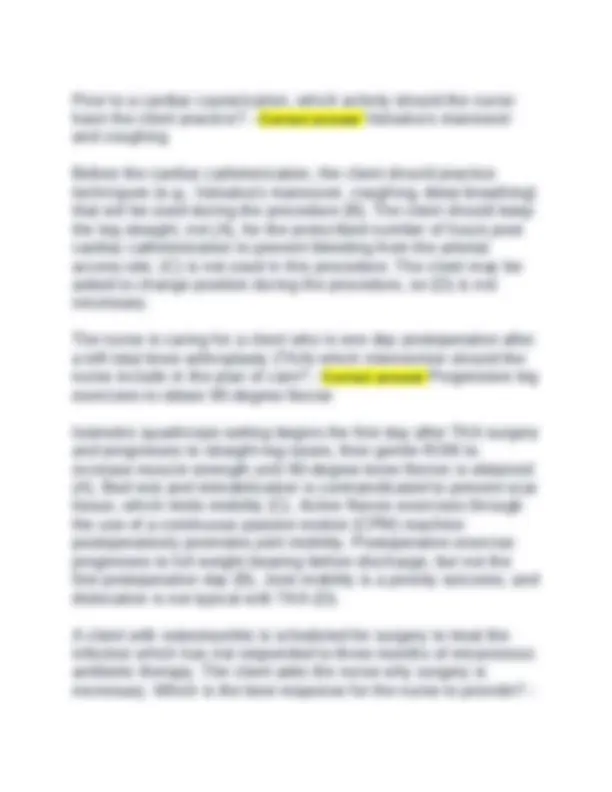
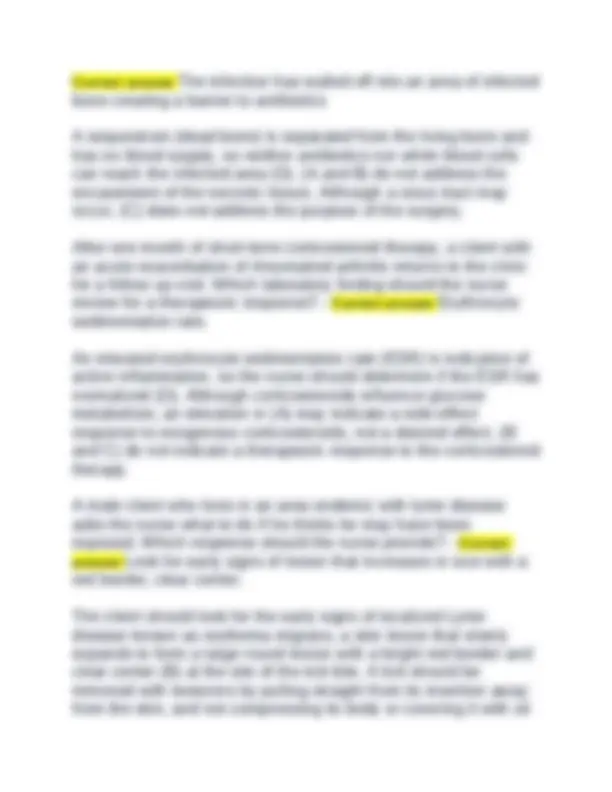
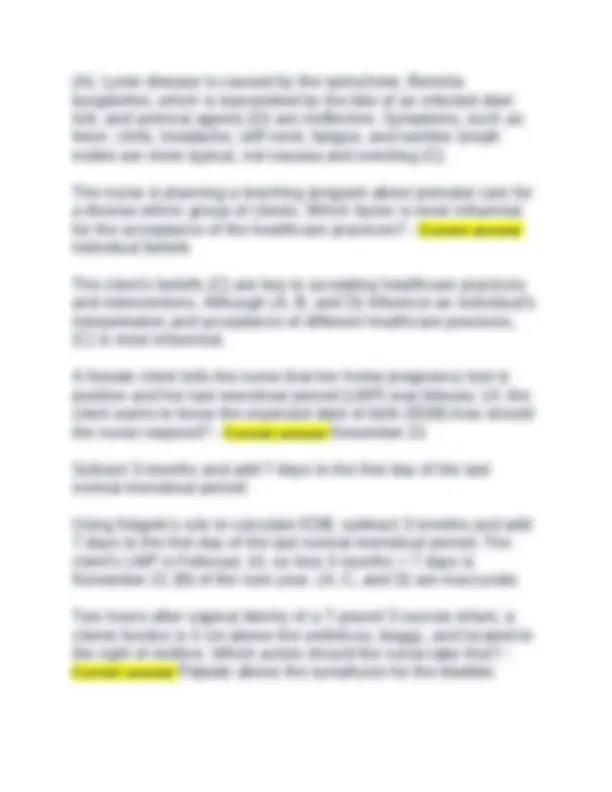
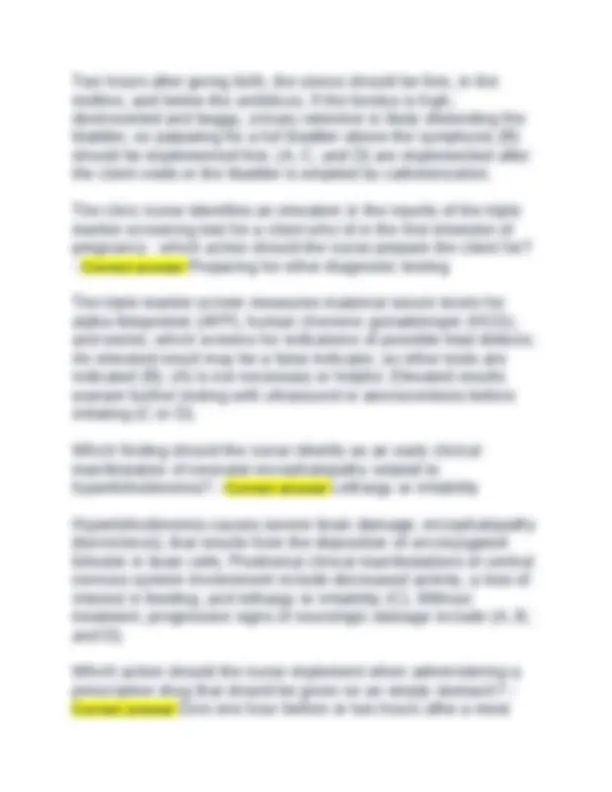
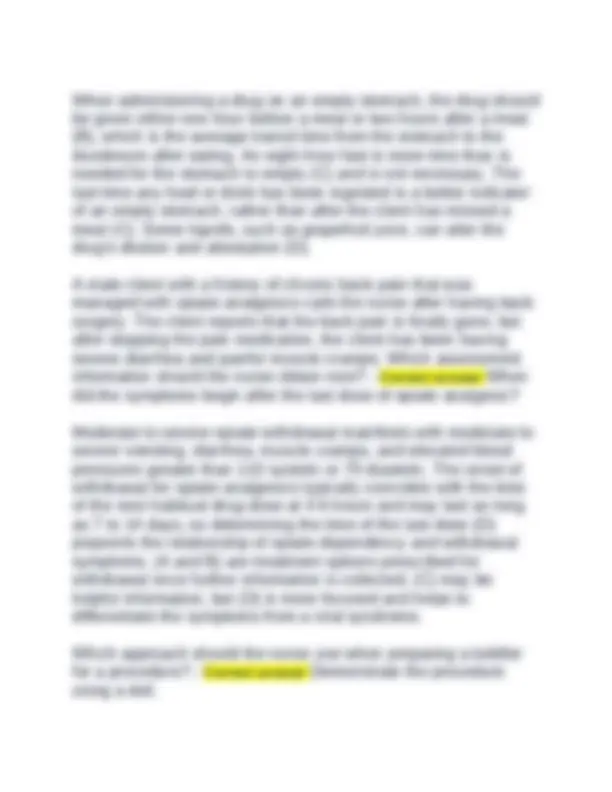
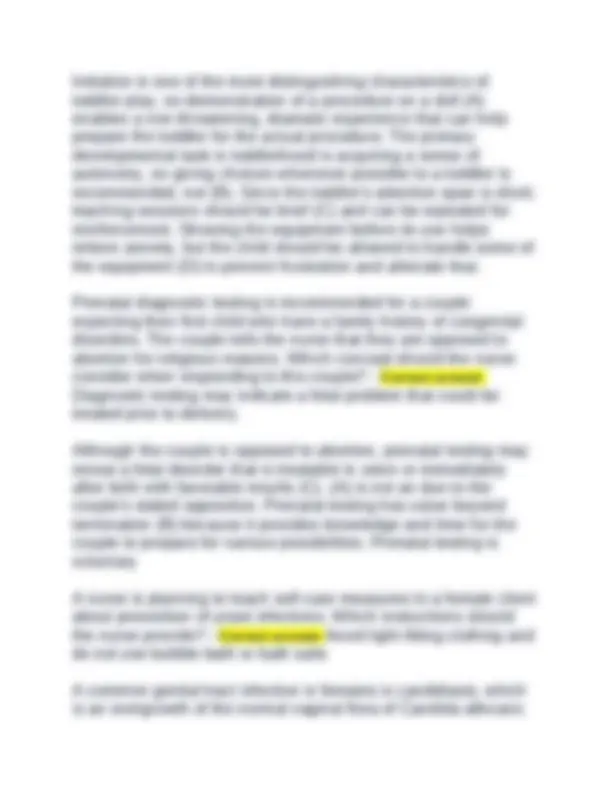
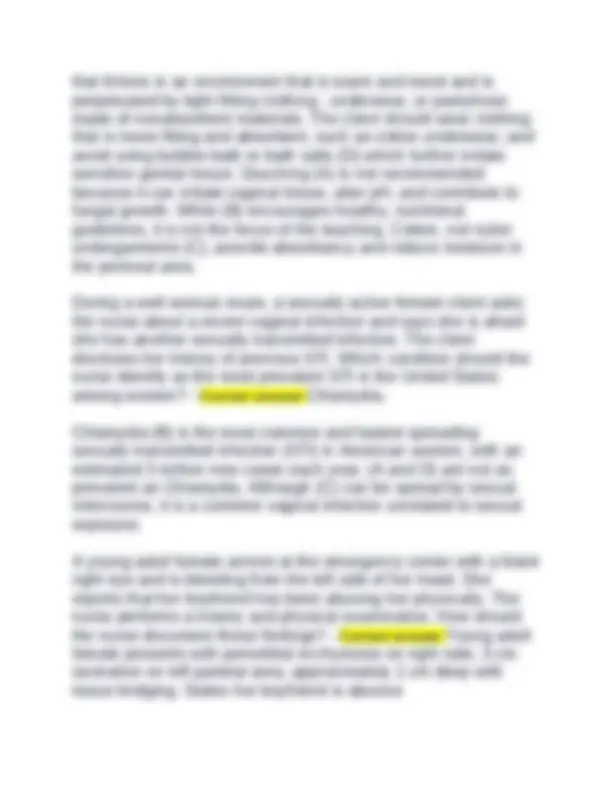
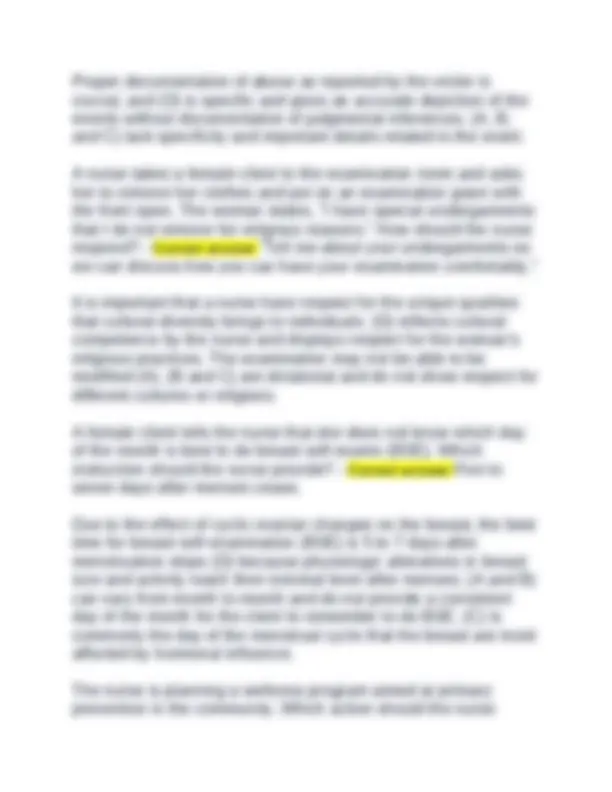
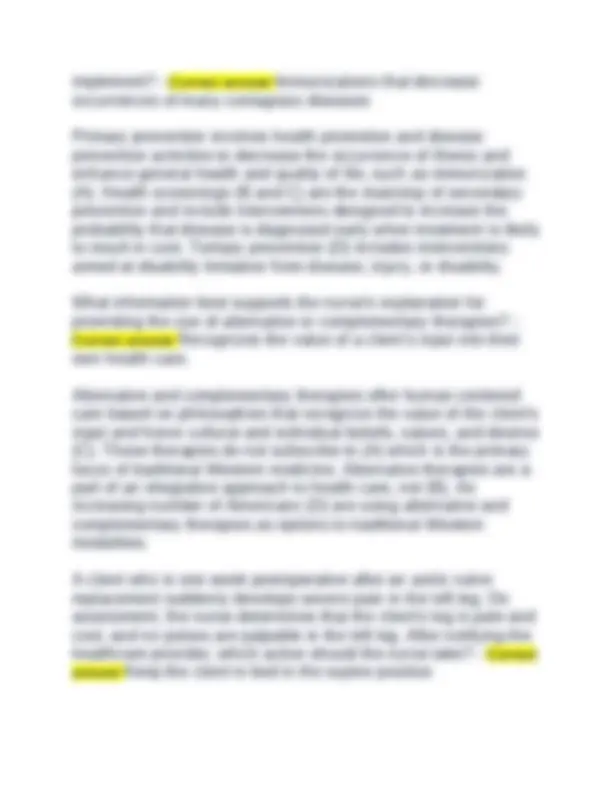
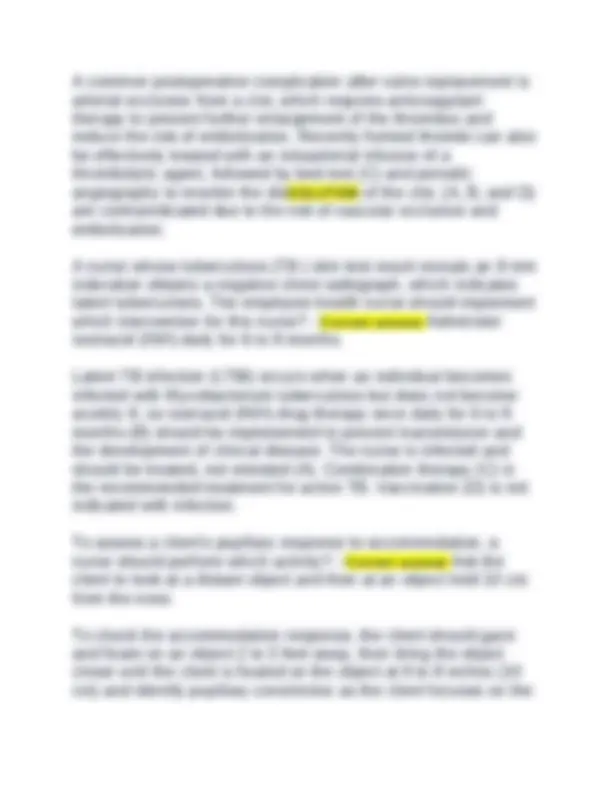
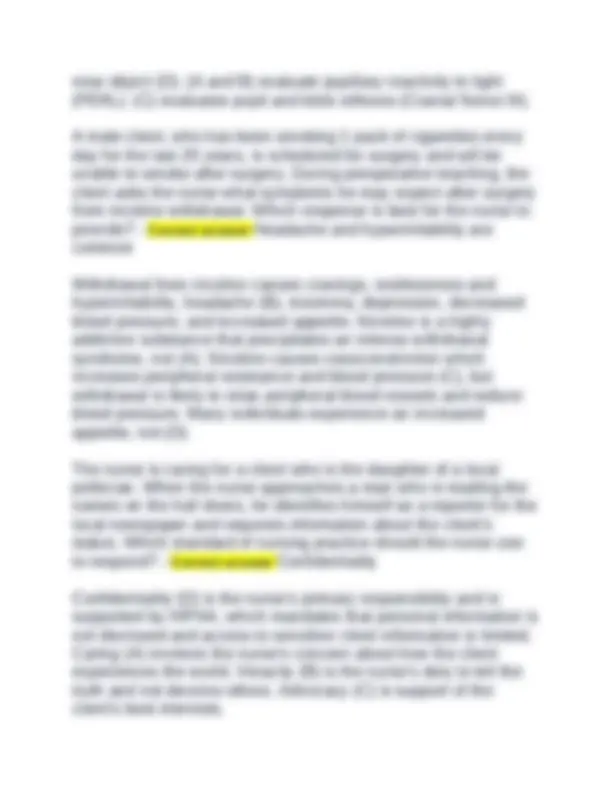
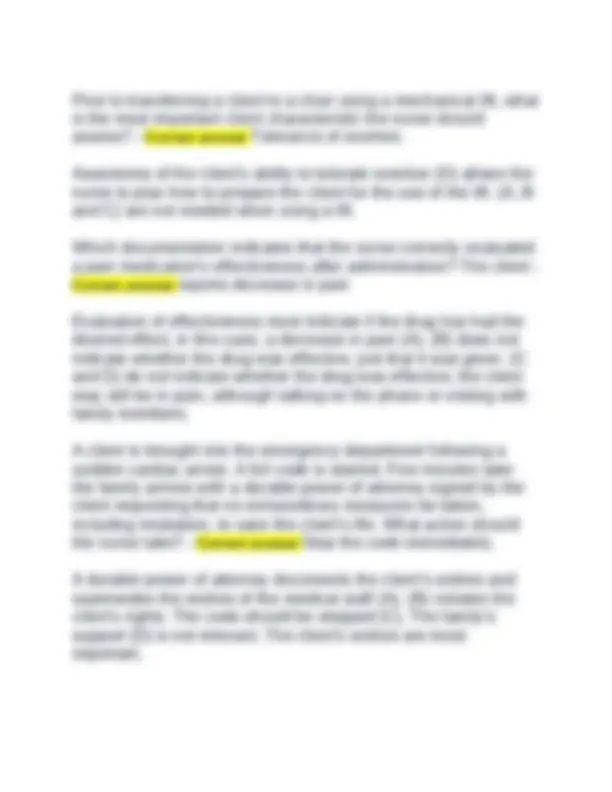
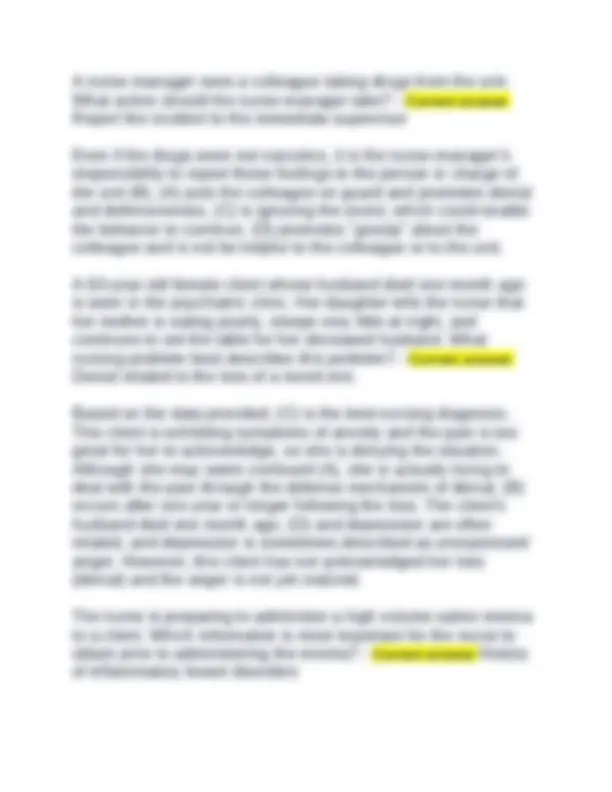
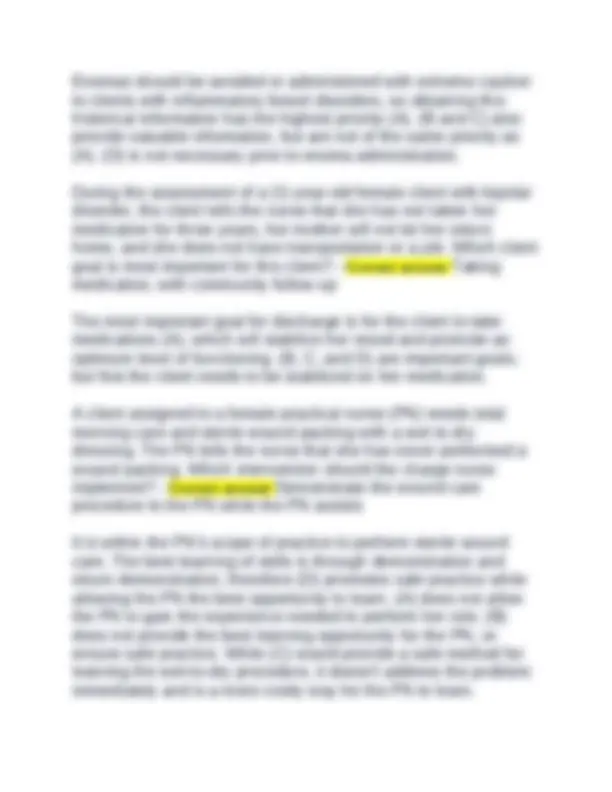
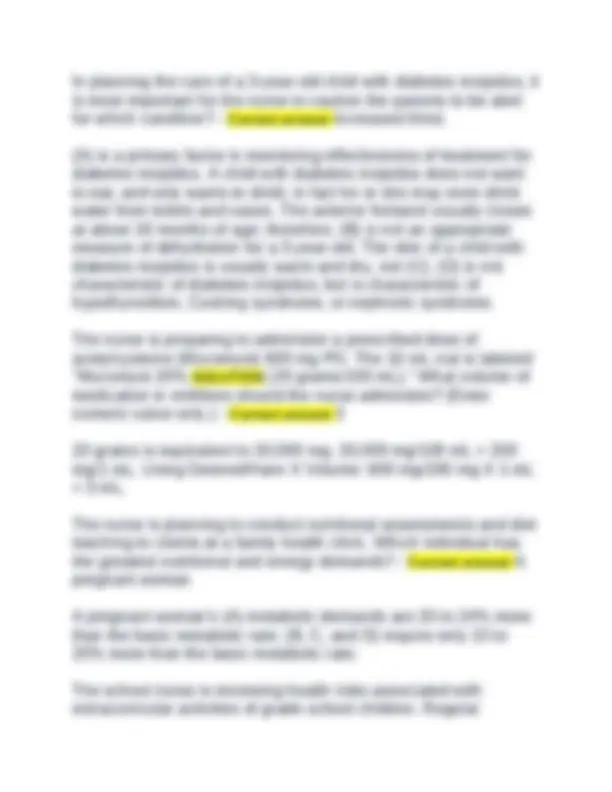
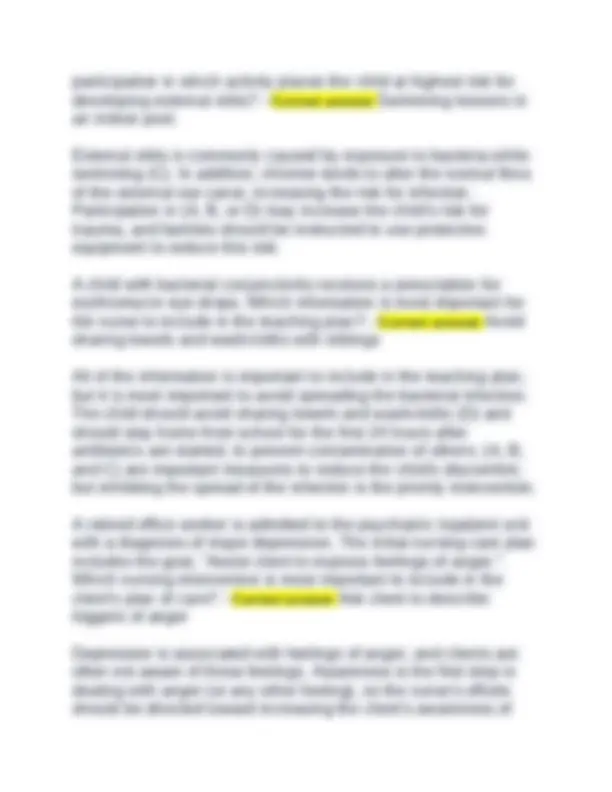
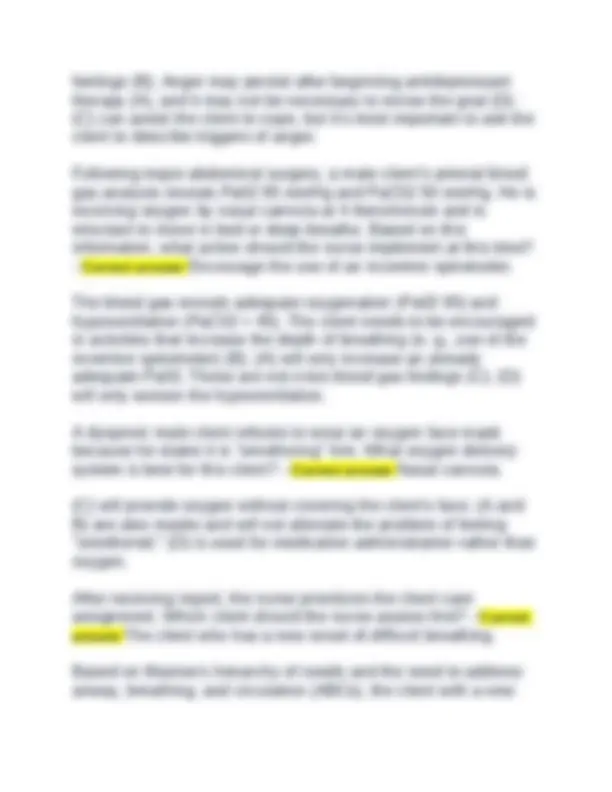
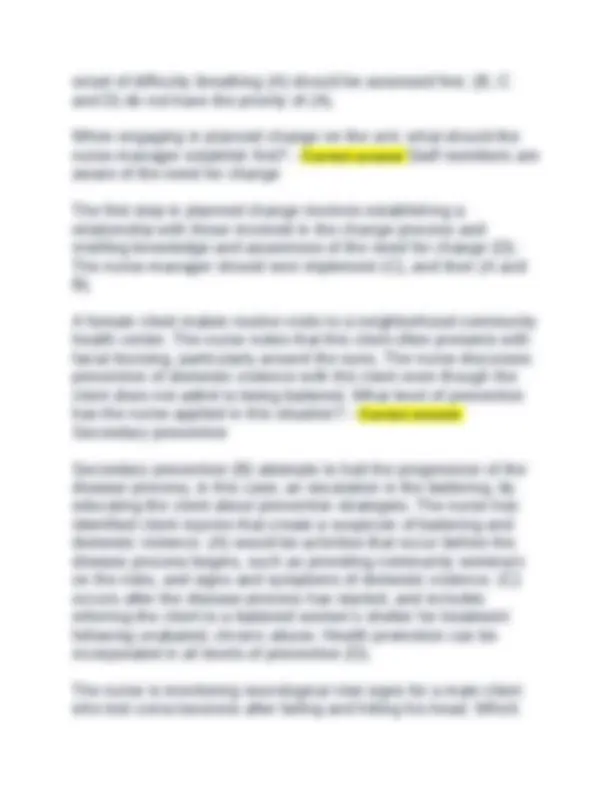
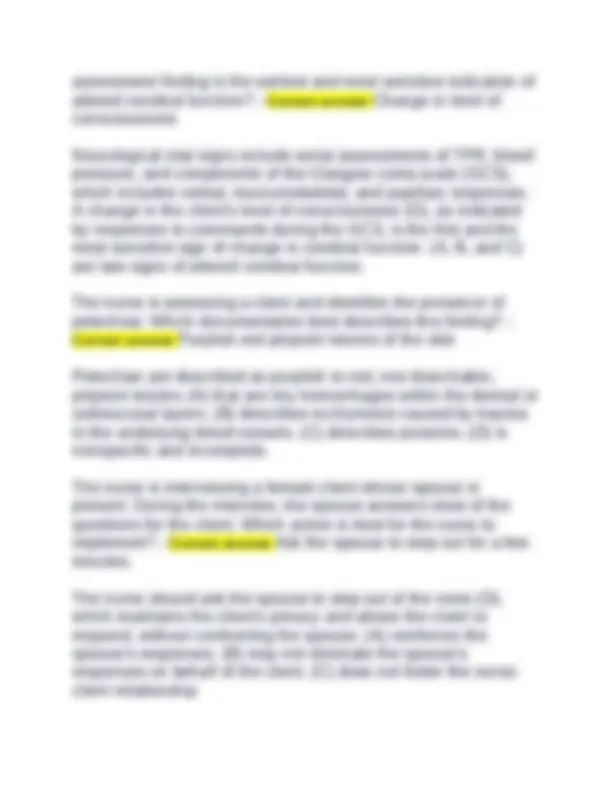
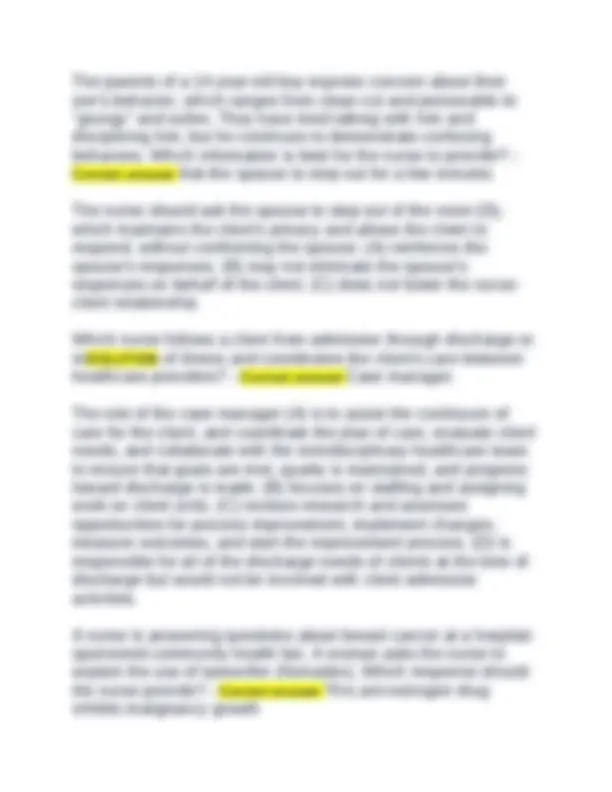
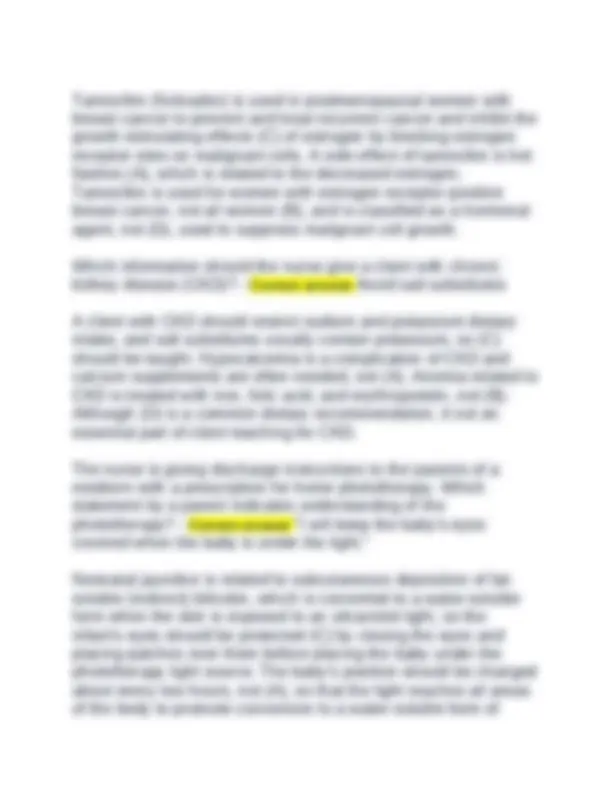
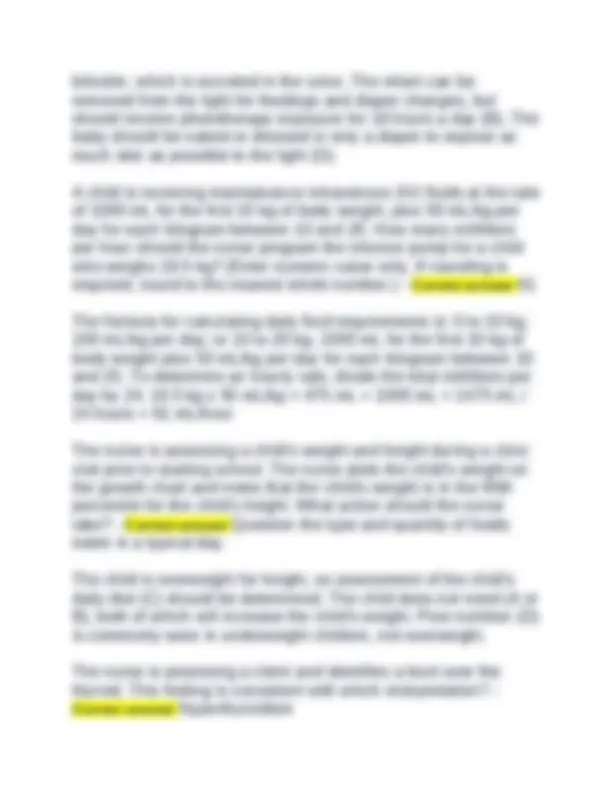
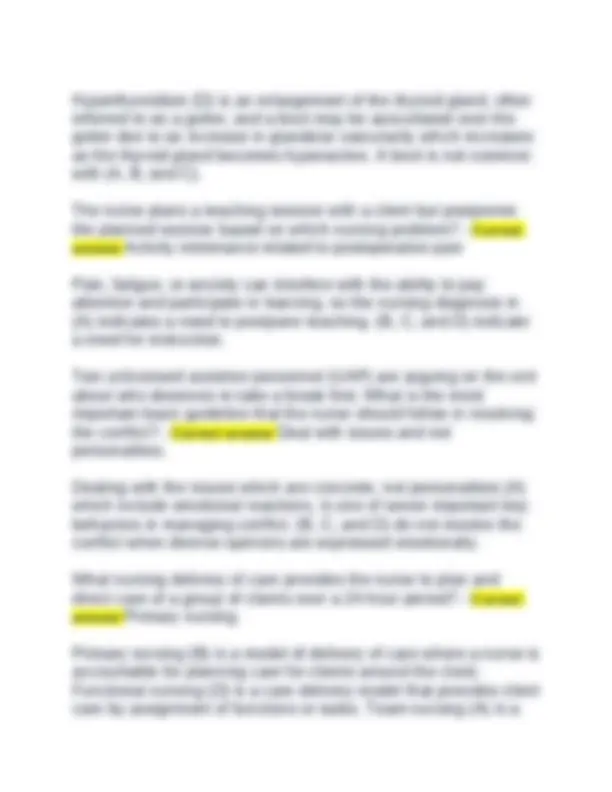
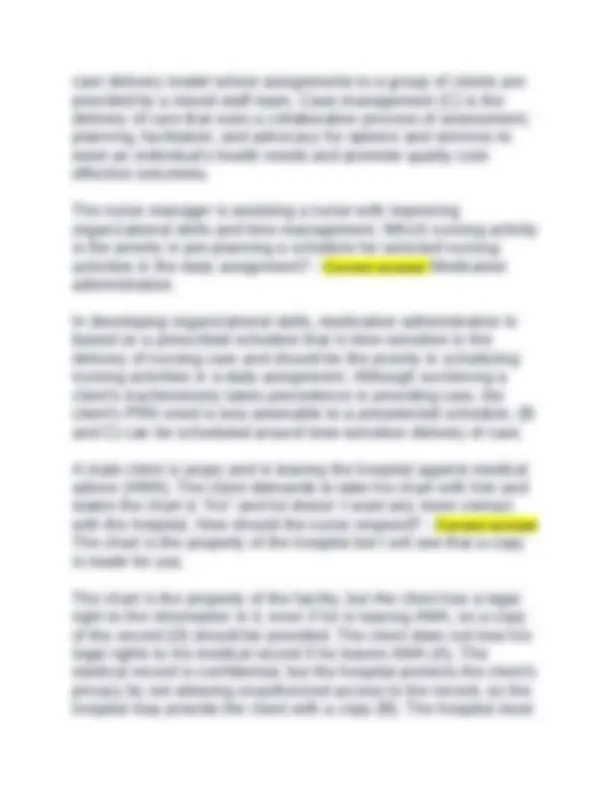
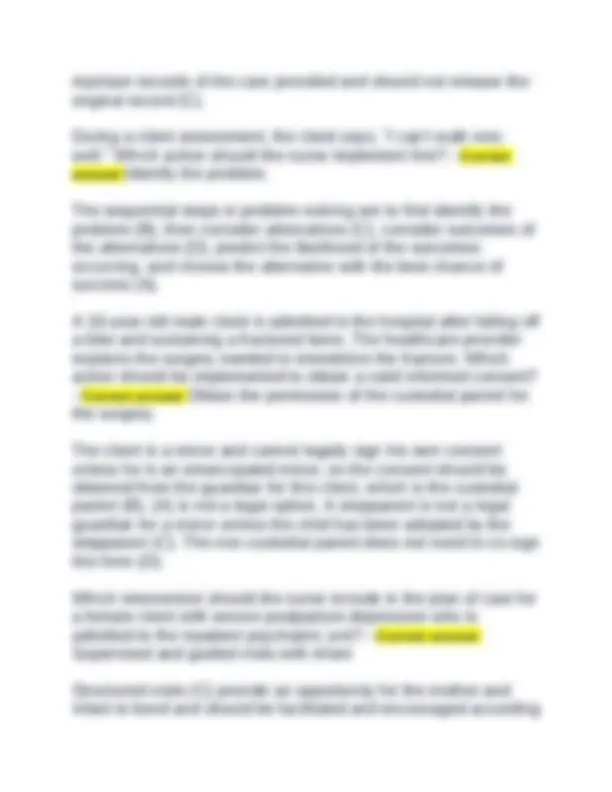
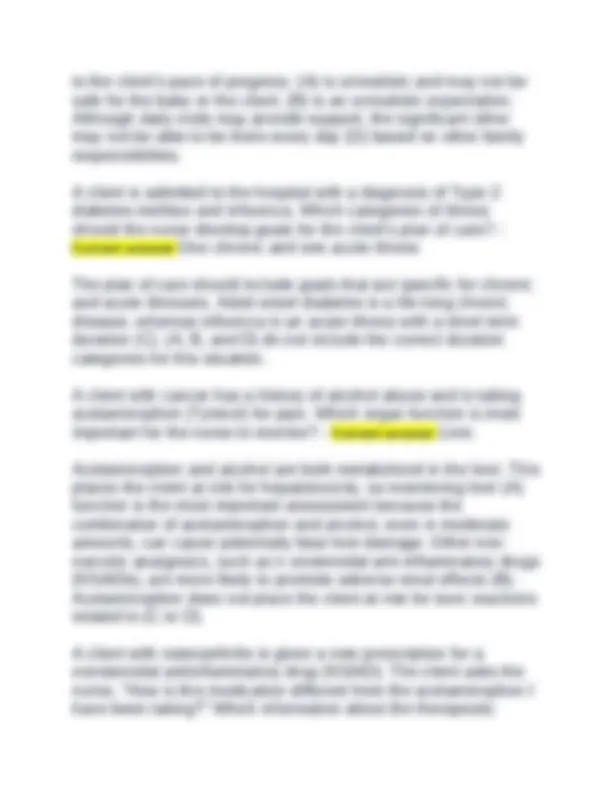
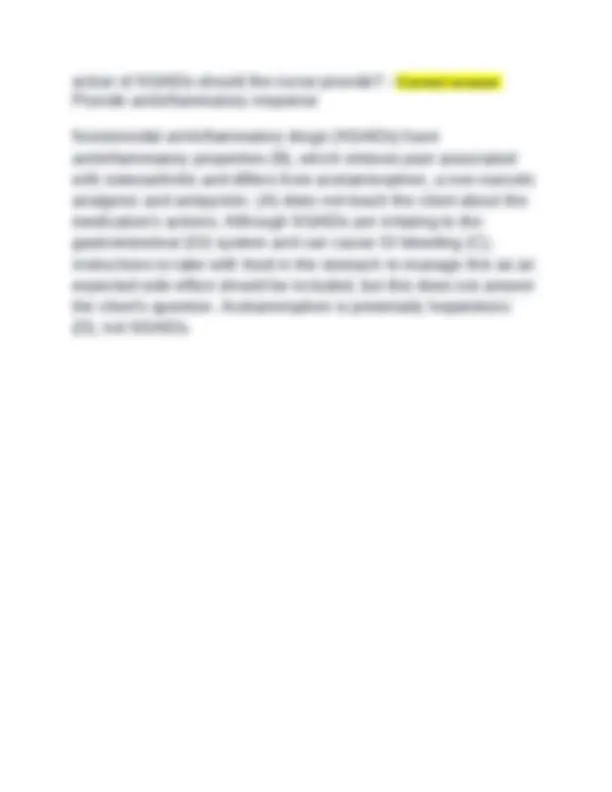


Study with the several resources on Docsity

Earn points by helping other students or get them with a premium plan


Prepare for your exams
Study with the several resources on Docsity

Earn points to download
Earn points by helping other students or get them with a premium plan
Community
Ask the community for help and clear up your study doubts
Discover the best universities in your country according to Docsity users
Free resources
Download our free guides on studying techniques, anxiety management strategies, and thesis advice from Docsity tutors
Evolve Comprehensive Exam (Hesi) 1 Questions and Answers. Evolve Comprehensive Exam (Hesi) 1 Questions and Answers.
Typology: Exams
1 / 49

This page cannot be seen from the preview
Don't miss anything!










































A client with asthma receives a prescription for high blood pressure during a clinic visit. Which prescription should the nurse anticipate the client to receive that is at least likely to exacerbate asthma? A. Pindolol (Visken). B. Carteolol (Ocupress). C. Metoprolol tartrate (Lopressor). D. Propranolol hydrochloride (Inderal). - Correct answer Metoprolol Tartrate( Lopressor) The best antihypertensive agent for clients with asthma is metoprolol (Lopressor) (C), a beta2 blocking agent which is also cardioselective and less likely to cause bronchoconstriction. -Pindolol (A) is a beta2 blocker that can cause bronchoconstriction and increase asthmatic symptoms. -Although carteolol (B) is a beta blocking agent and an effective antihypertensive agent used in managing angina, it can increase a client's risk for bronchoconstriction due to its nonselective beta blocker action. -Propranolol (D) also blocks the beta2 receptors in the lungs, causing bronchoconstriction, and is not indicated in clients with asthma and other obstructive pulmonary disorders. A male client who has been taking propranolol ( inderal) for 18 months tells the nurse the healthcare provider discontinued the medication because his blood pressure has been normal for the past three months. Which instruction should the use provide? - Correct answer Ask the health care provider about tapering the drug dose over the next week.
Although the healthcare provider discontinued the propranolol, measures to prevent rebound cardiac excitation, such as progressively reducing the dose over one to two weeks (C), should be recommended to prevent rebound tachycardia, hypertension, and ventricular dysrhythmias. Abrupt cessation (A and B) of the beta-blocking agent may precipitate tachycardia and rebound hypertension, so gradual weaning should be recommended. A client who is taking clonidine ( Catapres, Duraclon) reports drowsiness. Which additional assessment should the nurse make? - Correct answer How long has the client been taking the medication Drowsiness can occur in the early weeks of treatment with clonidine and with continued use becomes less intense, so the length of time the client has been on the medication (A) provides information to direct additional instruction. (B, C, and D) are not relevant. The nurse is preparing to admister atropine, an anticholinergic, to a client who is scheduled for a cholecystectomy. The client asks the nurse to explain th reason for the prescribed medication. What response is best for the nurse to provide? - Correct answer Decrease the risk of bradycardia during surgery Atropine may be prescribed preoperatively to increase the automaticity of the sinoatrial node and prevent a dangerous reduction in heart rate (B) during surgical anesthesia. (A, C and D) do not address the therapeutic action of atropine use perioperatively. An 80 year old client is given morphine sulphate for postoperative pain. Which concomitant medication should the nurse question
The nurse identifies a clients needs and formulates th nursing problem of " Imbalancee nutrition: Less than body requirements, related to mental impairment and decreased intkae, as evidence by increasing confusion and weight loss of more than 30 pounds over the last 6 months. " which short-term goal is best for this client? - Correct answer Eat 50% of six small meals each day by the end of the week Short-term goals should be realistic and attainable and should have a timeline of 7 to 10 days before discharge. (A) meets those criteria. (B) is nurse-oriented. (C) may be beyond the capabilities of a confused client. (D) is a long-term goal. the nursie is caring for a client who is unable to void. The plan of care establishes an objective for the client to ingest at least 1000 mL of fluid between 7:00 am and 3:30pm. Which client response should the nurse document that indicates a successful outcome?
Active tuberculosis requires implementation of airborne precautions, so the client should be assigned to a negative pressure air-flow room (D). Although (A and C) should be implemented for clients in isolation with contact precautions, it is most important that air flow from the room is minimized when the client has TB. (B) should be implemented when the client leaves the isolation environment. A client is receiving atonal (tenormin) 25 mg PO after a myocardial infraction. The nurse determines the clinents apical pulse is 65 beats per minute. What action should the nurse implement next? - Correct answer Administer the medication Atenolol, a beta-blocker, blocks the beta receptors of the sinoatrial node to reduce the heart rate, so the medication should be administered (C) because the client's apical pulse is greater than 60. (A, B, and D) are not indicated at this time. A 6 year old child is alert but quiet when brought to the emergency center with periobital ecchymosis and ecchymosis behind the ears. The nurse suspects potential child abuse and continues to assess the child for additional manifestations of a basilar skull fracture. What assessment finding would be consistent with the basilar skull fracture? - Correct answer Rhinorrhoea or otorrhoea with halo sign Raccoon eyes (periorbital ecchymosis) and Battle's sign (ecchymosis behind the ear over the mastoid process) are both signs of a basilar skull fracture, so the nurse should assess for possible meningeal tears that manifest as a Halo sign with CSF leakage from the ears or nose (D). (A) is consistent with orbital fractures. (B) occurs with wrenching traumas of the shoulder or arm fractures. (C) occurs with blunt abdominal injuries.
The nurse is developing a teaching plan for an adolescent with a milwaukee brace. Which instruction should the nurse include? - Correct answer Wear the brace over a T-shirt 23 hours a day. Idiopathic scoliosis is an abnormal lateral curvature of the spine in adolescent females. Early treatment uses a Milwaukee brace that places pressure against the lateral spinal curvature, under the neck, and against the iliac crest, so it should be worn for 23 hours per day over a T-shirt (D) which reduces friction and chafing of the skin. (A, B, and C) reduce the effectiveness of the brace. A 9 year old is hospitalized for the neutropenia and is placed in reverse isolation. The child asks the nurse " why do you have to wear a gown and mask when you are in my room?" How should the nurse respond? - Correct answer " To protect you because you can get an infection very easily Reverse isolation precaution implement measures to protect the client from exposure to microorganisms from others (B). Although microbes are prevalent in all environments, (A) does not adequately answer the child's question. Reverse isolation should be implemented until the client's white blood cell increases (C). Neutropenia in this child does not place others (D) at risk for infection. A male client who had abdominal surgery has a nasogastric tube to suction, oxygen per nasal cannula, and complains of dry mouth. Which action should the nurse implement? - Correct answer Apply a water soluble lubricant to the lips, oral mucosa and nares. To ease the client's discomfort, a water soluble lubricant to the lips and nares assists to keep the mucous membranes moist (D). (A) is a petroleum-based product and should not be used because it is flammable. (B and C) should not be given to the
client with a nasogastric tube to suction because it can cause further distension and interfere with fluid and electrolyte balance. The nurse is assessing the laboratory results for a client who is admitted with renal failure and osteodystrophy. Which findings are consistent with this client's clincail picture? - Correct answer Serum potassium of 5.5 mEq and total calcium of 6 mg/dl. In renal failure, normal serum electrolyte balance is altered because the kidneys fail to activate vitamin D, calcium absorption is impaired, and serum calcium decreases, which stimulates the release of PTH causing resorption of calcium and phosphate from the bone. A decreased tubular excretion and a decreased glomerular filtration rate results in hypocalcemia, hyperphosphatemia, and hyperkalemia (C). (A) is reflective of a non-renal cause, such as dehydration or liver pathology. (B) is more indicative of infection. Renal failure causes anemia and hyperphosphatemia, not (D). A 56 year old female client is receiving intracavitary radiation via a radium implant. Which nurse should be assigned to care for this client? - Correct answer A nurse with marfran's syndrome who is postmenopausal. A client receiving intracavity radiation poses a radiation hazard as long as the intracavity radiation source is in place. A nurse's ability to care of this client is not affected by Marfan's syndrome (B), which is a hereditary disorder of connective tissues, bones, muscles, ligaments and skeletal structures. The goal is to limit any one staff member's exposure to the calculated time span based on the half-life of radium, such as the number of minutes at the bedside per day, so (A) should not be assigned. (C) should not be exposed to the radiation due to the possible effect on the fetus. A radiation exposure decreases the immune response in
Obesity is a body weight that is 20% above desirable weight for a person's age, sex, height, body build, and calculated body mass index (BMI). (C) best identifies factors that contribute to the formulation of the nursing diagnosis. (A and B) are medical classifications for a client's weight. Although the client is at an increased risk for several chronic illnesses (D), such as heart disease, diabetes mellitus, hypertension, coronary artery disease and hyperlipidemia, this is not a contributing cause or related factor that supports the nursing diagnosis. The nurse is inspecting the external eye structures for a client. Which finding is a normal racial variation? - Correct answer An African-American Client may have slightly yellow sclerae. Recognizing normal variations that are common in different racial groups helps the nurse differentiate an early sign of pathology, such as yellow sclerae. A slightly yellow color of the sclera for (C) is a normal racial variation found in the African-American population. (A, B, and D) are findings not related to one racial group. During the physical assessment, which finding should the nurse recognize as a normal finding? - Correct answer Regular pulsation at the epigastric area when the client is supine. Recognizing normal findings in the physical exam is a necessity. The regular and recurrent expansion and contraction of an artery produced by waves of pressure caused by the ejection of blood from the left ventricle as it contracts is a normal finding (A). (B, C, and D) are abnormal findings that require further assessment. When documenting assessment data, which statement should the nurse record in the narrative nursing notes? - Correct answer S Murmur auscultated in supine position.
Documentation of subjective and objective data obtained from the physical assessment should be communicated using precise, descriptive, clear, and accurate information, such as auscultated heart sounds while the client is in a specified position (C). (A, B, and D) are nonspecific. A female client reports to the nurse that her sleep was interrupted by " thoughts of anger towards my husband" What type of thoughts is the client having? - Correct answer Obsessive Obsessive thoughts (A) are thoughts that the client is unable to control. (B) are irrational fears. (C) are false beliefs. (D) are suspicious thoughts The nurse attempts to notify the healthcare provider about a client who is exhibiting an extrapyramidal reaction to psychotropic medications. When the receptionist for the answering service offers to take a message , which nursing action is best for the nurse to take? - Correct answer Tell the receptionist to have the healthcare provider return the phone call. The best nursing action is to ask for a return call from the healthcare provider (B) because the nurse must maintain the client's confidentiality. (A) is acceptable, but the best action is to leave a telephone number and request a return call. (C or D) do not promote confidentiality. A primipara with a breech presentation is in the transition phase pf labor. The nurse visualizes the perineum and sees the umbilical cord extruding from the introitus. In which position should the nurse place the client? - Correct answer Supine with the foot of the bed raised
Which group is likely to besot effective in developing the new care map? - Correct answer Multisicipilinary group In a multidisciplinary work group (B), a number of individuals from a variety of disciplines are involved in developing the care map, but each works independently to implement the care plan. Single- discipline work groups (C), such as (A or D), are likely to focus on the aspects of the care map related only to their specific discipline. the scope of professional nursing practice is determined by rules promulgated by which organization.? - Correct answer State's board of nursing The state's Board of Nursing (A) is authorized to promulgate rules and regulations that carry the weight of law. The State Legislature delegates its law-making authority to this administrative law body. (B and C) are influential in defining and describing nursing standards of care, but neither have the authority to pass laws that legally define the professional scope of nursing practice. Although (D) may rule on issues important to nursing practice, the scope of professional nursing practice is determined by the laws, rules, and regulations promulgated by state Boards of Nursing. An older client who has been bedridden for a month is admitted with a pressure ulcer on the left trochanter area. The nurse determines that the ulcer extends into the subcutaneous tissue. At which stage should the nurse document this finding? - Correct answer Stage 3 Pressure ulcers develop over skin surfaces usually covering bony prominences and are caused by external pressure that impedes blood flow, causing ischemia of the skin and underlying tissue. The stage of the pressure area is determined by the depth of tissue damage, and this client's lesion should be documented as
a Stage 3 (C) because it is a full thickness tissue loss with visible subcutaneous fat that does not expose bone, tendon, or muscle. (A) is a nonblanchable pressure point over intact skin. (B) is a partial thickness ulcer, such as a ruptured blister or shallow open ulcer with a pink wound bed. (D) is a full thickness tissue loss with exposed bone, tendon or muscle, slough or eschar, and often includes undermining and tunneling. When meeting with the client and the family, which nursing intervention demonstrates the nurses role as collaborator of care?
best answer to this question. It is important to avoid (D) in order to avoid perforating the sutures on the bronchial stump following a pneumonectomy. The nurse is conducting a drug education class for junior high school students. Which statement, provided by one of the student participants, best describes the primary characteristic of addiction? - Correct answer wanting the drug is all that matter to an addict The hallmark characteristic of addiction is impaired control (D): all that matters is obtaining the drug of choice. (A) may or may not be true, but is not the primary characteristic of addiction. (B) is a manifestation of impaired control. Addiction is not caused by being unhappy with one's self, but such unhappiness is usually a result of addiction (C). the nurse is caring for critically ill clients. Which should be monitored for the development of neutogenic shock? A client with? - Correct answer Spinal cord injury Spinal cord injuries (C) place the client at high risk for the development of neurogenic distributive shock. The development to watch for in (A) is cardiogenic shock, in (B) is hemorrhagic shock, and in (D) is hypovolemic shock. Which statement by the community health nurse is most helpful to an adult who is in a crisis situation? - Correct answer You seem to be more tense these days. Would you like to talk about the problem and how you are dealing with it? (D) acknowledges the stress and encourages the client to discuss options to deal with the problems. Recognizing early signs/symptoms of heightened stress can help to avert a crisis. (A and C) deny the client the opportunity to take control of the
problem and use problem solving techniques to resolve the situation. (B) may be offering false reassurance. The nurse is teaching staff in a long term - facility home the principles of caring for clients with essential hypertension. Which comment should the nurse include in the inservice presentation about the care of clients with hypertension? - Correct answer Frequent blood pressure checks, including readings taken automated machines are recommended Frequent blood pressure checks (D) are recommended for hypertensive clients to evaluate the effectiveness of treatment. Symptoms such as (A) are not typical of essential hypertension, which is an asymptomatic disease. Treatment (B) usually includes dietary modifications and exercise, which should not be discontinued when medications are added to the treatment plan. While the RN is ultimately responsible for the assessment of blood pressures (C), caregivers are not restricted from obtaining the blood pressure readings. A client is admitted to the hospital for alcohol dependency. What is the priority nursing intervention during the first 48 hours following admission? - Correct answer Monitor for increased blood pressure and pulse Clients with alcohol dependency experience withdrawal symptoms, which include elevated blood pressure, pulse, and temperature, so (B) has the highest priority. (A) will prevent Korsakoff's syndrome (secondary dementia caused by thiamine deficiency, associated with malnutrition secondary to excessive alcohol intake), but this intervention does not have the priority of (B). (C and D) are important for alcohol detoxification, but do not have the priority of (B).
aggressive treatment should be if the client should ever be in a coma or persistent vegetative state, and lists any medical treatments they would never want performed (B). (A) is the definition of the "Living Will"; some states and Canada do not consider Living Wills legal documents. A durable power of attorney is a legal document (C), and it is not a hospital form (D). After eye drops are instilled, which instruction should the nurse provide to the client? - Correct answer Close your eyelids Gently closing the eyelids (C) without blinking (D) allows the medication to spread over the eye. It is usually helpful for the client to tilt their head back (A) while the eye drops are being instilled. (B) will not assist in medication distribution or absorption. the nurse is preparing to administer IV fluid to a client with strict fluid restriction. IV tubing with which feature is most important for the nurse to select? - Correct answer A Buretrol Attachment A buretrol attachment is used to restrict the total volume of IV fluids that a client receives (D). (A and B) control the rate of administration, but not the total volume infused. (C) reduces the risk of infusion of particulates but does not control the volume infused. Lasix 20 mg PO is prescirbed for a client at 0600. the medication is available in a sound tablet of 40 mg. Before breaking the tablet, what action should the nurse take? - Correct answer Preform hand hygiene Before breaking a scored tablet, the nurse should perform hand hygiene (B) to ensure medical asepsis. (A and C) are unnecessary. The nurse should administer the medication before charting (D).
Which assessment finding should make the nurse suspect that a 21 year old male client is taking anabolic steroids - Correct answer Describes working hard to develop muscles Anabolic steroids, exogenous androgens, increase muscle mass (C). (A) is an adverse effect that occurs with females that are taking anabolic steroids, but not in males. Acne (B) is a potential side effect of anabolic steroids, but it is such a common occurrence in young males that it should not be the main indication of steroid use. A 10-pound weight gain (D) does not mean the young man is using steroids unless the weight gain is due to increased muscle mass. Which instruction should the nurse include in the discharge teaching for a client who is taking an antipsycotioc medication? - Correct answer Increase daily intake of raw fruits and veggies A common side effect of antipsychotic medications is constipation, and increasing high-fiber foods in the diet (A) can help to alleviate this problem. (B and C) have no particular effect on possible side effects from taking antipsychotic medications. While some antipsychotic medications cause urinary retention, which should be reported to the healthcare provider, urine output increase (D) is likely to occur if additional fluids are consumed to overcome a dry mouth, which is a common side effect of antipsychotic medications. Prior ro the discharge of a family 4-day old newborn the nurse is collecting the blood specimens to screen for phenylketonuria(PKU), the Guthrie inhibition assay blood test. What action should the nurse implement to ensure the validity of the test? - Correct answer Assess the newborns feeding patterns of formula or breast milk which has come in